SGP1000 high-efficiency deburring and edge rounding machine with belt and spiral barrel combination
专业砂光机制造商
本公司专业从事技术行业,我们专注于砂光机的研发,为用户提供大量的选择。如果您想选择适合钣金去毛刺机、宽带磨床的生产厂家,请与我们联系。
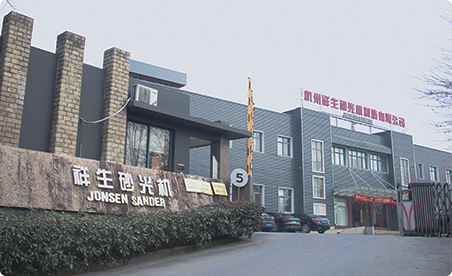
完美的加工工艺
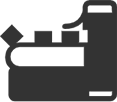
适用于各种材料
优质的售后服务

专业的&
值得信赖的

广泛的应用
电力零部件工业、汽车精密零部件、非金属绝缘板、摩擦材料、精密钣金制造、轨道交通设备制造、航空航天、核电等特种材料加工、工程、农业机械、,板材加工,医疗器械。
设备介绍
我们的设备适用于加工各种材料的工件,如铜、铝、不锈钢、软钢等。
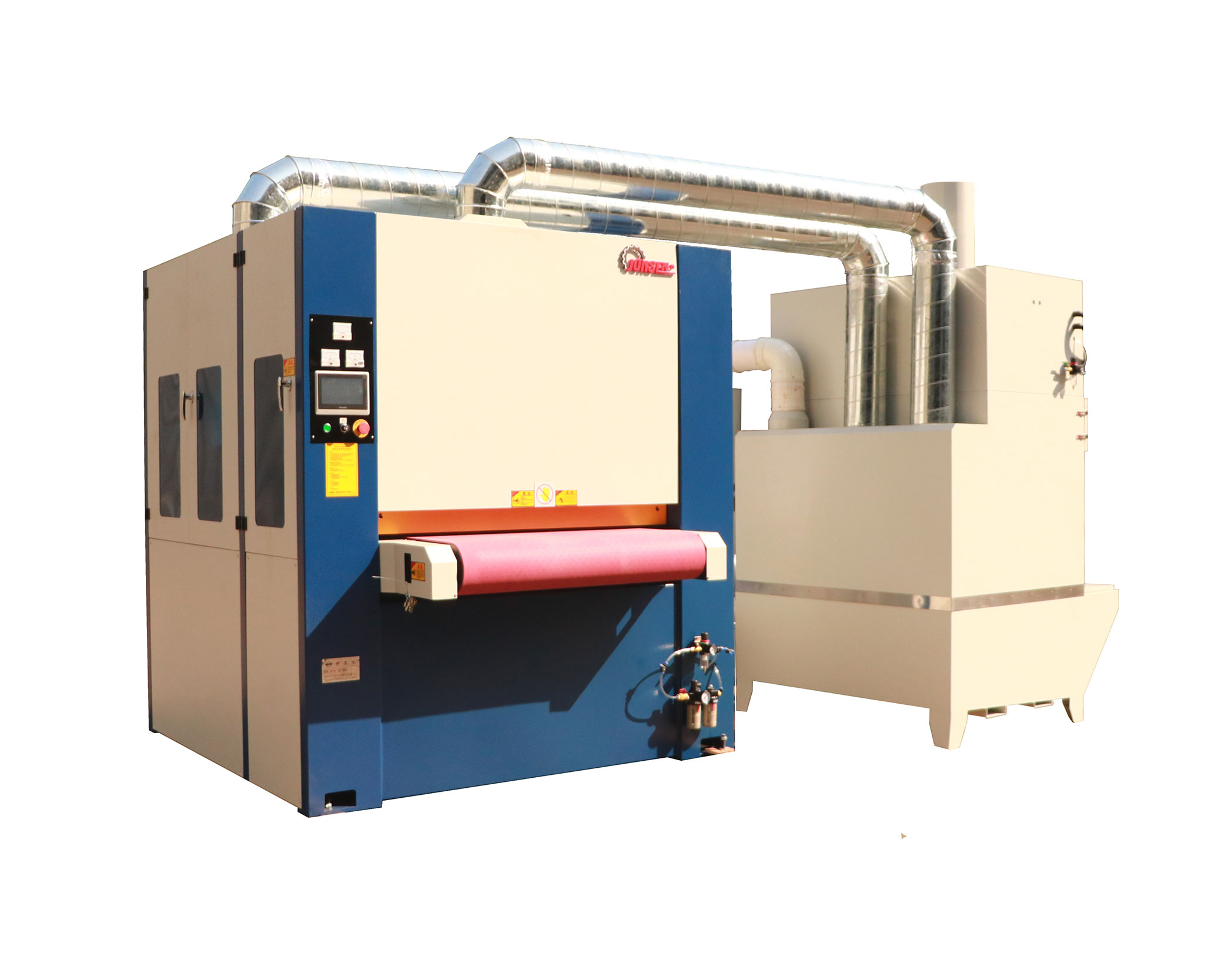
SGP1000 is a high-efficiency deburring and edge rounding machine equipped with one wide abrasive belt station and four spiral abrasive barrels. It is specially designed for laser-cut, punched, and sheared metal parts, delivering consistent edge rounding and clean surface finishing in a compact, user-friendly system.
SGP1000 high-efficiency deburring and edge rounding machine with belt and spiral barrel combination
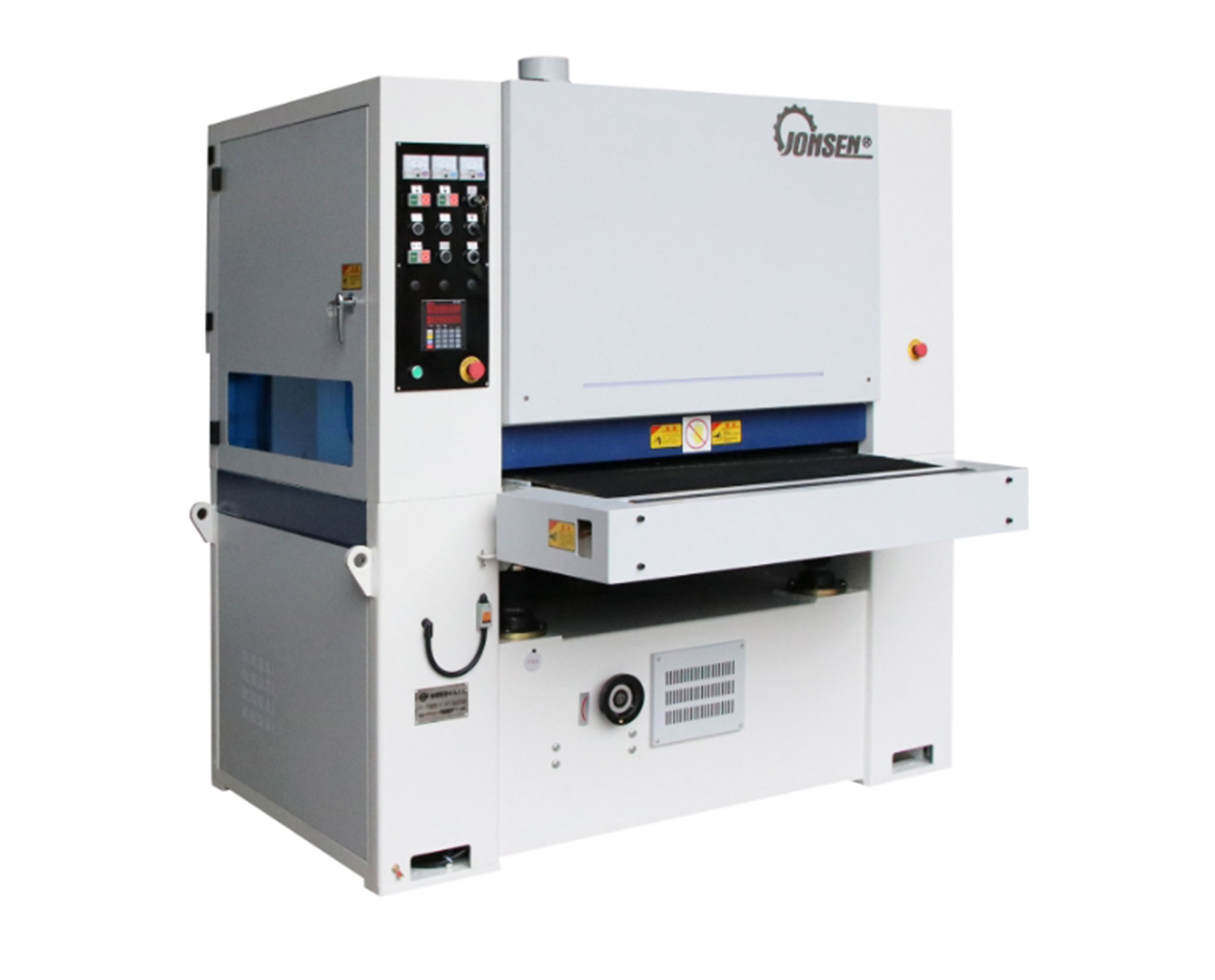
Machine description:
SG1030-NG+JS is a high-efficiency deburring, slag removal, and surface finishing machine specially designed for laser-cut metal parts, ensuring clean edges and smooth surfaces for steel, stainless steel, aluminum, and more.
SG1030-NG+JS high-efficiency deburring, slag removal & surface finishing machine for laser-cut parts

It is specially used for batch burr removal, edge blunting, surface polishing, surface drawing, etc. of laser cutting blanking parts. The core grinding station adopts up to four grinding methods, which can be used in combination to greatly improve processing efficiency.
SGPGB1000 Metal Surface and Edge All-in-One Solution

SGP1300 Wide abrasive belt head for sanding out the burrs or surface finishing,Planetary type abrasive barrel station for further edge rounding, 8 abrasive barrels (4 in clockwise rotation, and 4 in counter-clockwise rotation), and planetary rotation.
SGP1300 High efficiency deburring edge rounding and surface finishing machine
应用解决方案
切割和冲孔圆角平面工件
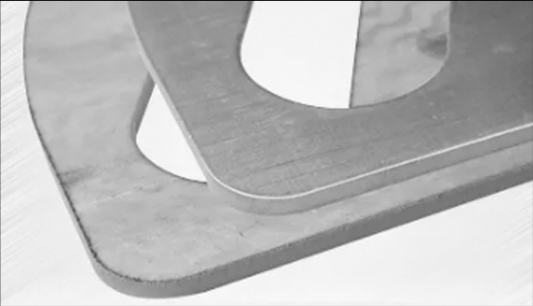
等离子、火焰、激光除渣

表面除锈、激光除氧

新闻
公司新闻
和行业信息

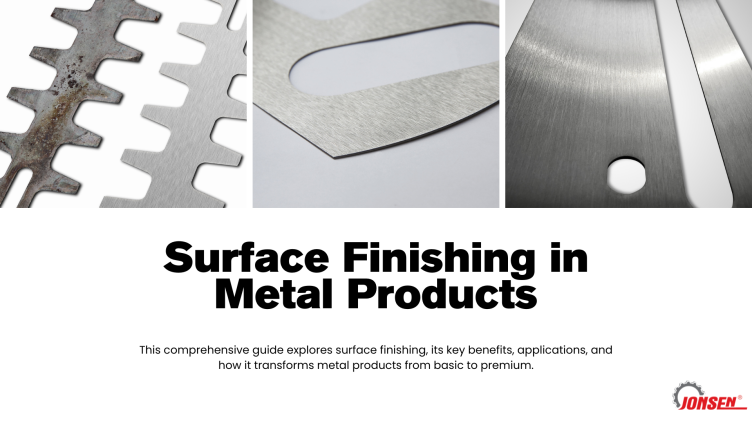
Automated Metal Finishing Solutions for Sheet Metal and Stainless Steel
Every component leaving a production line carries more than just its shape and dimensions—it carries a surface that must resist corrosion, meet safety standards, and satisfy aesthetic demands. Metal finishing transforms raw parts into reliable, high-quality products ready for real-world use. Whether a panel is destined for a car body, a surgical instrument, or an architectural facade, finishing defines its performance and customer perception. Yet finishing is not a one-size-fits-all step; it involves multiple methods, materials, and technologies. This guide explores the most common finishing processes, compares wet and dry approaches, examines manual versus automated solutions, and highlights the return on investment manufacturers can achieve by modernizing their finishing operations.
At its core, metal finishing enhances both functionality and appearance. Burrs, tool marks, and uneven surfaces are inevitable in machining, cutting, or forming operations. Finishing addresses these flaws by smoothing edges, improving paint adhesion, and creating protective layers. It also tailors surface properties: some finishes improve conductivity, others increase wear resistance, while certain treatments reduce friction or enhance biocompatibility. Without finishing, even a precision-machined component may fail prematurely due to corrosion or fatigue. In industries where reputation and safety define success, manufacturers cannot ignore the strategic role of finishing. It directly influences warranty claims, customer satisfaction, and compliance with standards such as ISO 9001 and ASTM specifications.
Also called brushed or architectural finishes, directional finishes feature uniform polishing lines running along the part. They are widely used in stainless steel appliances, elevators, and building panels because they combine visual appeal with defect masking. These finishes are typically achieved using 120–180 grit belts, followed by finer abrasives to soften the pattern.
Non-directional finishes display no consistent grain pattern. Their randomness conceals scratches and makes them suitable for high-contact areas such as handrails or automotive interiors. Orbital sanders and automated finishing machines often produce this effect in a single pass.
Produced directly from rolling mills or drawing dies, mill finishes are economical but lack visual refinement. They serve as a base for further treatments like anodizing or coating, and are common in industrial equipment, pipes, and refrigeration units.
Mirror finishes are highly reflective and smooth, eliminating crevices that could harbor contaminants. They are crucial for medical devices, food processing equipment, and luxury products. Achieving this finish requires multiple polishing stages, often with wet finishing machines for consistency.
Beyond these four, manufacturers rely on anodizing (for aluminum corrosion resistance), electroplating (to apply protective or decorative layers), powder coating (for durable colored surfaces), and bead blasting (for matte textures). Together, these techniques offer a toolbox to meet nearly any functional or aesthetic requirement.
Finishing can be carried out using either wet or dry systems, and the choice significantly affects results. Wet finishing uses coolant or water to reduce heat and friction, resulting in smoother surfaces and longer abrasive life. It is especially valuable for stainless steel, aluminum, and thin sheet metals where overheating risks warping. Dry finishing, on the other hand, eliminates the need for coolant handling and is better suited for ferrous metals and applications where speed is prioritized. However, dry methods generate more dust, requiring robust extraction systems. In many modern shops, hybrid systems allow both wet and dry operations, offering flexibility while maximizing quality and cost-efficiency. For industries like medical or aerospace, wet finishing is often non-negotiable due to the stringent surface requirements.
For decades, metal finishing was performed manually using grinders, files, or polishing wheels. Skilled operators could deliver high-quality results, but manual finishing is inconsistent, slow, and risky. Fatigue and variability lead to uneven finishes, while workers face exposure to dust and repetitive strain injuries. Automated metal finishing machines address these issues by standardizing processes. Equipped with conveyor belts, abrasive belts, and multi-head configurations, they finish both sides of a part in seconds. Automation ensures repeatability, reduces scrap, and frees workers from hazardous tasks. Consider a shop processing 15,000 stainless panels per year: manual polishing consumes over 2,500 hours annually, whereas automation reduces it to under 400 hours. The result is a safer workplace and products that consistently meet customer specifications.
Selecting equipment for metal finishing requires balancing current needs with future scalability. Factors to consider include:
Material compatibility: Machines must handle stainless, aluminum, and high-strength alloys.
Part size range: Flexible conveyors and pinch rollers accommodate small and large components.
Desired finishes: Directional, non-directional, or mirror-polish capabilities often require multi-head systems.
Wet vs dry capability: Hybrid machines increase versatility.
Dust and coolant management: Integrated collection and filtration systems ensure operator safety.
Automation and control: Servo-driven gap adjustments, recipe storage, and inline inspection improve quality control.
Investing in modular machines that integrate deburring, edge rounding, and finishing functions provides long-term value, reducing handling and floor space.
Automotive: Finishing ensures car bodies resist corrosion, while decorative finishes enhance consumer appeal. High-volume finishing machines also prepare chassis parts for coating.
Architecture: Stainless steel facades and elevator interiors rely on directional finishes for aesthetics and durability. Finishing protects against fingerprints, scratches, and environmental wear.
Medical: Smooth, mirror-polished finishes eliminate contamination risks in surgical tools and implants. Stringent finishing ensures biocompatibility and compliance with regulatory standards.
Energy and Rail: Components exposed to weather or stress benefit from non-directional and coated finishes that extend service life.
Electronics: Consumer products like smartphones and appliances depend on flawless finishes for both tactile appeal and functional performance. In electronics, surface finishing also impacts conductivity and thermal management.
Across these industries, finishing is a competitive necessity, not just a cosmetic choice.
The cost of finishing is often underestimated. Manual finishing of 20,000 parts per year may cost $300,000 in labor and rework. An automated finishing machine cuts cycle time from 8 minutes to under 1 minute, reducing labor costs by more than 80%. Factoring in scrap reduction and improved coating adhesion, ROI is typically achieved within 18 months. Beyond direct savings, automation enables manufacturers to win contracts requiring strict quality consistency. Customers increasingly demand traceability and repeatability—something only automated finishing can deliver. In short, metal finishing machines are not expenses, but profit multipliers.
Since 1993, Hangzhou Xiangsheng Abrasive Machine Manufacturing Co., Ltd. has advanced surface treatment technology. With 23 invention patents, over 80 utility model patents, and contributions to 20 industry standards, Xiangsheng leads the field in deburring, grinding, edge rounding, and finishing equipment. The company has delivered over 10,000 solutions to industries including automotive, aerospace, medical, and nuclear energy. Xiangsheng’s finishing machines combine heavy-duty frames, customizable head counts, wet/dry versatility, and intelligent control systems. These innovations help manufacturers achieve consistent finishes, reduce costs, and meet evolving global standards.
Q1: How do wet and dry finishing systems compare in terms of operating cost?
Wet systems extend abrasive life and reduce scrap but require coolant handling. Dry systems are faster for ferrous metals but need advanced dust extraction. Hybrid machines balance both.
Q2: Does finishing affect dimensional tolerances of precision parts?
Controlled finishing removes minimal material. Advanced machines with servo controls ensure tolerances remain within microns, making them suitable for aerospace and medical applications.
Q3: What’s the difference between polishing and finishing?
Polishing focuses on aesthetics, creating shine and smoothness. Finishing enhances both appearance and functionality, improving adhesion, corrosion resistance, and wear properties.
Q4: How do automated finishing machines handle mixed part sizes?
Specialized conveyors, pinch rollers, and modular heads allow machines to process both small components and large sheets in the same line, maximizing flexibility.
Q5: What ROI can manufacturers expect from automation?
Typical ROI ranges from 12–24 months, depending on volume. High-volume shops see payback faster, often within a year, through labor savings, reduced scrap, and contract wins.
Q6: Are finishing requirements different for stainless steel and aluminum?
Yes. Stainless requires higher abrasive force, while aluminum is prone to scratching and benefits from wet finishing. Machines must adapt settings to each material.
Q7: Can finishing improve sustainability in manufacturing?
Absolutely. Better adhesion means fewer recoats and less material waste. Automation reduces dust exposure and energy use, aligning with green manufacturing goals.
Q8: How does finishing integrate with other surface processes?
Modern equipment often combines deburring, edge rounding, oxide removal, and finishing in one pass, streamlining workflows and reducing handling costs.
Metal finishing is more than an aesthetic touch—it is a foundation of quality, safety, and reliability in global manufacturing. From brushed architectural panels to mirror-polished surgical tools, finishing defines product performance across industries. Manual methods may suffice for prototypes, but automated solutions deliver the consistency, efficiency, and ROI demanded by today’s markets. With decades of innovation and standard-setting, Xiangsheng equips manufacturers with advanced finishing technology to transform sharp, imperfect surfaces into durable, flawless products.
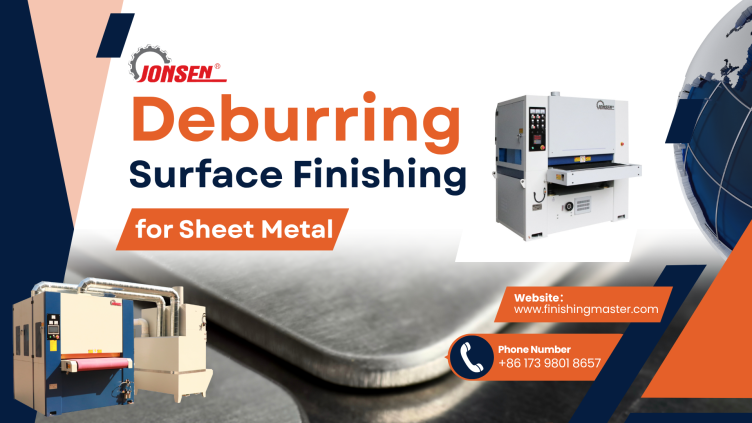
Automated vs Manual Metal Deburring: Which Delivers Better Results?
In the world of modern fabrication, companies invest heavily in advanced lasers, CNC machines, and robotics to push productivity forward. Yet one silent flaw often undermines the benefits of these high-tech processes: burrs. These small, sharp, unwanted fragments of metal may seem harmless at first glance, but they can jeopardize product quality, cause assembly failures, and endanger both workers and end-users. Without a proper strategy for metal deburring, even the most sophisticated production line faces hidden costs. Deburring is not simply a finishing step—it is a critical safeguard for performance, safety, and durability. In this article, we will explore why deburring matters, the techniques available, and how automated solutions create measurable ROI for manufacturers.
Burrs are the byproducts of machining, cutting, punching, and forming. Left untreated, they introduce a series of risks that accumulate throughout the lifecycle of a product. First, burrs compromise assembly fit by interfering with fastener seating or dimensional tolerances. This creates downstream rework and quality control headaches. Second, burrs are natural stress concentrators—tiny points where cracks can initiate under cyclic loading, dramatically reducing fatigue life. Third, burrs disrupt coatings, paints, or anodizing, creating spots for corrosion to begin. From an electrical standpoint, sharp edges concentrate static charges, increasing the risk of discharge. And finally, burrs are a safety hazard: handling sharp components leads to cuts, while burrs in high-speed machinery can cause premature wear or failure. By investing in metal deburring, manufacturers prevent these failures and unlock longer product lifespans.
At its core, metal deburring is the controlled removal of burrs and sharp edges to create smooth, safe, and functional parts. The process is not uniform; it must adapt to component geometry, burr size, and production volume. Traditionally, deburring began with manual methods such as filing, grinding, or sanding, often carried out by skilled workers. While effective for prototypes or small batches, this approach is slow, inconsistent, and labor-intensive. As industries scaled, automated solutions emerged: brushing systems, abrasive belts, mass finishing equipment, and robotic arms equipped with deburring heads. Each method offers different advantages, from precision in hard-to-reach areas to high throughput in mass production. Today, deburring is considered a secondary but essential process that defines whether a product meets safety, reliability, and performance standards.
Deburring is not a one-size-fits-all process. Different techniques are used depending on part complexity, material, and quality requirements:
Mass Finishing: Ideal for large batches, where parts tumble in abrasive media. Efficient but less precise for individual features.
Brushing: Rotating brushes with metal filaments scrape off burrs, often used for sheet metal edges.
Manual Deburring: Files, grinders, and sanders provide localized control but are slow and inconsistent.
Robotic Deburring: Robotic arms fitted with abrasive tools offer repeatability for complex shapes.
Mechanical Deburring: Machines with rollers or wheels apply uniform force, useful for sheet metal.
Electrochemical Deburring (ECD): Combines electricity and electrolyte solution to dissolve burrs in precise locations, ideal for high-value aerospace or medical parts.
Waterjet Deburring: Uses high-pressure water to erode burrs, effective for heat-sensitive components.
Each method has trade-offs in cost, precision, and throughput. Selecting the right approach requires balancing production needs with performance expectations.
The debate between manual and automated deburring is essentially a debate between variability and reliability. Manual deburring relies on human skill, making it prone to inconsistency. Two operators may produce two different results on identical parts. Moreover, manual labor consumes valuable hours: finishing a single part may take 5–10 minutes, multiplied by thousands of units annually. Safety is another issue, as repetitive strain and sharp edges increase injury risks. Automated deburring, by contrast, delivers consistency at scale. Machines can deburr parts in under a minute with repeatable accuracy, regardless of batch size. Automated systems also integrate dust collection and safety guards, protecting workers from exposure. The result is a dramatic improvement in both throughput and workplace safety, making automation the preferred choice for competitive manufacturers.
Different industries depend on deburring for different reasons, but all share the need for reliability:
Automotive: Burr-free parts ensure coatings adhere, welds hold, and fasteners seat correctly, improving both safety and appearance.
Aerospace: Precision is non-negotiable. Deburring prevents fatigue cracks in critical components, extending aircraft lifespan.
Medical Devices: Patient safety demands flawless surfaces. Deburring removes sharp edges and contamination traps in surgical tools and implants.
Energy and Rail: Large steel plates and components exposed to stress and weather must be deburred to prevent corrosion.
Electronics: Burr-free edges prevent static discharge and ensure proper fit in delicate assemblies.
In every sector, deburring is not just about compliance—it is about building trust and delivering products that perform under real-world conditions.
Investing in a metal deburring machine requires evaluating several factors:
Part Size and Geometry: Are you processing large plates, small components, or both? Some machines can handle a wide range of sizes.
Material Type: Stainless steel, aluminum, and high-strength alloys each require specific abrasive media and force settings.
Burr Characteristics: Heavy burrs may require abrasive belts, while fine edges benefit from brushes.
Volume: High-volume shops benefit from inline automated systems; small batches may only need semi-automated solutions.
Integration: Machines with modular heads (deburring, edge rounding, oxide removal) provide multi-process efficiency.
Maintenance and Support: A robust dust extraction system, reliable spare parts, and responsive technical support ensure uptime.
The right equipment should align not only with today’s needs but also with future scalability.
Deburring may seem like an added cost, but the financial benefits quickly outweigh the investment. Consider a factory producing 50,000 laser-cut parts per year. At 8 minutes per part manually, labor costs exceed $400,000 annually. Automated deburring machines reduce cycle time to under 1 minute per part, cutting labor costs by more than 80%. Scrap reduction, fewer warranty claims, and improved coating adhesion add further savings. Most companies recover their investment in 12–24 months. Beyond numbers, automation delivers strategic advantages: improved safety, compliance with international standards, and stronger customer confidence. In a global market where quality and reliability are differentiators, metal deburring is a source of competitive edge.
Since 1993, Hangzhou Xiangsheng Abrasive Machine Manufacturing Co., Ltd. has been at the forefront of surface finishing technologies. As the first establishment unit of China’s metal sanding machine standard, Xiangsheng has authored 20 industry standards and holds 23 invention patents plus over 80 utility model patents. With more than 10,000 solutions delivered worldwide, Xiangsheng provides advanced deburring machines, wide belt grinding systems, and edge rounding equipment. Designed for safety, precision, and scalability, Xiangsheng’s machines enable manufacturers to meet growing demands while reducing costs. By combining innovation with customer-focused engineering, the company ensures every solution enhances efficiency and long-term reliability.
Q1: How does burr removal improve fatigue performance in high-stress components?
Burrs act as stress concentrators. Under cyclic loading, cracks initiate at these weak points. Deburring removes such triggers, extending fatigue life by 20–40% in applications like aerospace or automotive suspensions.
Q2: What’s the difference between edge rounding and deburring?
Deburring removes unwanted protrusions, while edge rounding creates a controlled radius for better coating adhesion and stress distribution. Many modern machines integrate both in one process.
Q3: Which deburring method is best for stainless steel?
Stainless steel is harder and work-hardens easily. Abrasive belts or rotary brushes with higher contact pressure are effective. For medical-grade stainless, precision methods like electrochemical deburring are preferred.
Q4: Can automated deburring handle both small and large parts?
Yes. Advanced systems feature specialized conveyor belts that secure parts as small as 3" x 3" while accommodating large sheets, making them versatile for mixed production lines.
Q5: How do robotic deburring systems compare with dedicated deburring machines?
Robotic systems excel at complex geometries and high flexibility but may have slower cycle times. Dedicated deburring machines deliver faster throughput for standardized parts. Many shops use both, depending on their mix.
Q6: How do dust collection and safety systems add value to deburring machines?
Dust and particles from burr removal can be hazardous. Integrated extraction not only protects workers but also extends machine life and maintains surface quality, reducing long-term costs.
Q7: What is the typical payback period for a deburring machine?
Depending on production volume, most companies achieve ROI in 12–24 months. High-volume manufacturers often reach breakeven faster due to labor and scrap savings.
Q8: Does deburring affect dimensional tolerances?
When properly controlled, deburring removes burrs without altering critical dimensions. Machines with servo or hydraulic gap control ensure consistency within tight tolerances.
Burrs may be small, but their impact is enormous. From premature fatigue failure to poor coatings and workplace injuries, untreated burrs create cascading problems across industries. Metal deburring is the safeguard that ensures parts are safe, functional, and durable. Automated solutions not only improve efficiency but also deliver ROI, compliance, and customer trust. With decades of expertise, Xiangsheng provides manufacturers with world-class deburring technology, turning a hidden risk into a competitive advantage.

How Metal Edge Rounding Prevents Corrosion and Reduces Scrap
In metal fabrication, most managers focus on improving cycle times of lasers, welding robots, or bending machines. But in many cases, the hidden quality bottleneck lies at the edges of the part itself. Burrs, sharp corners, and untreated cutouts may look minor, yet they are often the reason why paint peels, corrosion spreads, or assemblies fail prematurely. These issues consume valuable time and money, while damaging customer trust. Metal edge rounding, also known as edge radiusing, offers a reliable solution. By systematically transforming sharp edges into controlled radii, manufacturers can extend product lifespan, enhance coating performance, and protect their workforce. In today’s competitive environment, this simple yet powerful process has evolved from a finishing afterthought into a strategic requirement.
Every cut or punched part leaves behind traces of mechanical or thermal stress. Burrs and vertical scallops are easy to overlook, but their effects are felt throughout production. Sharp edges reduce the effective bonding surface for paints and coatings, meaning layers of protection detach prematurely. Once a coating fails, moisture or chemicals exploit the weak spot, accelerating rust or oxidation. Beyond corrosion, burrs interfere with assembly, preventing flush fits or creating dimensional deviations. Operators are also at risk: even with gloves, handling sharp-edged panels often results in lacerations or repetitive strain injuries. Over time, untreated edges become a liability, multiplying hidden costs—whether through warranty claims, rework labor, or workplace incidents. This makes metal edge rounding not just a cosmetic process but a necessity for sustainable operations.
It’s common for non-specialists to confuse deburring with edge rounding, but the distinction is critical. Deburring removes burrs and protrusions, improving safety and appearance, while edge rounding deliberately creates a measurable radius—often up to 2 mm—on edges and cutouts. This radius ensures paints, powders, or functional coatings wrap smoothly around corners, avoiding thin spots that peel or crack. In addition, rounded edges distribute stress more evenly, reducing the chance of crack propagation under fatigue. The process also enhances part aesthetics, creating surfaces that look and feel premium. Importantly, many industries now specify edge radiusing in quality standards; for example, automotive OEMs frequently demand a minimum 2 mm radius before painting body panels. Thus, metal edge rounding is both a functional and regulatory requirement, separating world-class fabricators from competitors.
Traditionally, edge rounding was a manual task. Workers used files, grinders, or hand-held sanders to smooth corners. While this approach worked for prototypes or small batches, its drawbacks quickly became evident in larger production. Each worker applies pressure differently, leading to inconsistent radii across parts. Productivity also suffers: a single operator may spend 5–10 minutes per component, which is unsustainable in a factory producing thousands of sheets per week. Safety is another issue, as repetitive motions lead to strain injuries while sharp edges increase accident risks. By contrast, automated edge rounding machines transform efficiency. Equipped with abrasive belts, rotary brushes, or oscillating discs, they round both sides of a sheet simultaneously in under a minute. Quality is uniform across batches, settings are programmable, and integration with conveyors enables continuous flow. In fact, a mid-sized shop reported reducing annual edge finishing labor by 1,600 hours after switching to automation—proof that this technology reshapes productivity.
Modern edge rounding systems combine several advanced technologies to achieve consistent results. Abrasive belt modules remove heavy dross and prepare surfaces for further finishing. Rotary brush systems apply multi-directional force, ensuring that even internal cutouts receive uniform rounding. Oscillating discs target irregular geometries, preventing damage to protective films or sensitive coatings. To maintain precision, machines often integrate servo or hydraulic controls that regulate contact pressure across variable thicknesses. Equally important is the rise of multi-process lines: single machines capable of deburring, oxide removal, edge rounding, and even light surface finishing in one pass. This reduces handling time, improves safety, and maximizes ROI. A practical example is a customer using a brush-belt combination system: they simultaneously deburr laser-cut parts, round edges to 2 mm, and prepare surfaces for powder coating—all in less than 90 seconds per part.
The benefits of metal edge rounding span across multiple industries. In automotive, unrounded edges cause paint thinning and rust spots within months of use. Edge rounding ensures durable coatings and extends warranty periods. In aerospace, fatigue failure often originates at sharp edges; radiusing improves crack resistance, directly impacting passenger safety. Medical devices require flawless surfaces that are safe to handle and easy to sterilize; rounded edges prevent contamination traps. Rail transit and energy infrastructure depend on heavy plates that must withstand decades of exposure—edge rounding protects against rust propagation along edges and weld seams. Even in consumer electronics and appliances, rounded edges improve tactile quality, prevent injuries, and deliver the polished look demanded by premium brands. Across these sectors, the consistent lesson is clear: metal edge rounding is both a functional safeguard and a market differentiator.
Edge rounding is often perceived as an additional cost, but the numbers tell a different story. Manual finishing of 20,000 parts per year at 6 minutes each consumes nearly 2,000 labor hours, costing over $120,000 annually at standard shop rates. By contrast, automated systems reduce the cycle to under a minute, cutting labor to fewer than 400 hours. This saves more than $90,000 per year, not including reduced scrap or fewer warranty claims. ROI is typically achieved within 12–24 months, making edge rounding equipment one of the fastest payback investments in a fabrication shop. The competitive edge extends beyond cost savings: companies deliver consistent quality, meet global standards, and secure customer trust. In industries where one failed coating can cost millions in recalls or downtime, edge rounding becomes a strategic insurance policy rather than a discretionary expense.
As Industry 4.0 reshapes manufacturing, edge rounding is becoming smarter and more connected. Machines are now equipped with sensors that monitor brush wear, pressure, and contact time, ensuring consistent results with minimal operator input. AI-driven algorithms can automatically select process parameters based on material thickness, hardness, or part geometry, reducing setup time and human error. Data connectivity allows machines to integrate with MES or ERP platforms, ensuring full traceability of surface treatment steps. Sustainability is another driver: better adhesion means less wasted paint and fewer defective parts, directly reducing environmental impact. Some advanced systems even use predictive analytics to schedule maintenance before brushes or belts fail, avoiding costly downtime. In this way, edge rounding has evolved from a manual chore to a digitally integrated, environmentally responsible process, aligning perfectly with smart factory goals.
Since its founding in 1993, Hangzhou Xiangsheng Abrasive Machine Manufacturing Co., Ltd. has built a reputation as a pioneer in surface treatment. The company has authored 20 industry standards and holds 23 invention patents along with more than 80 utility model patents. With over 10,000 solutions delivered globally, Xiangsheng supports sectors ranging from automotive and aerospace to nuclear power and medical equipment. Its portfolio includes deburring systems, wide belt grinding machines, and advanced edge rounding solutions. Designed with rigid frames, multi-process integration, and intelligent control, Xiangsheng’s machines enable manufacturers to achieve consistent 2 mm edge radii while improving safety and efficiency. By partnering with Xiangsheng, companies gain not just equipment but a reliable ally in solving their surface treatment challenges.
Q1: Why is a 2 mm edge radius often required for coated parts?
A 2 mm radius is considered the benchmark because it ensures paint or powder coatings wrap around corners without thinning. Without rounding, coatings may peel within months, creating corrosion hotspots. Automotive OEMs and heavy machinery manufacturers increasingly specify this radius in quality standards.
Q2: How does edge rounding differ for stainless steel vs aluminum?
Stainless steel, being harder, demands more aggressive abrasives and higher contact forces. Aluminum, though softer, scratches easily, so machines must apply controlled pressure and often use protective films. Both materials benefit from automation, but parameter optimization is key to achieving uniform results.
Q3: Can edge rounding influence welding performance?
Yes. Rounded edges fit more easily into fixtures, reduce stress concentrations at weld seams, and ensure uniform penetration. In high-stress environments like aerospace or rail transit, this translates to stronger, more durable joints.
Q4: What’s the ROI difference between manual and automated edge rounding?
Manual rounding is slow and inconsistent, consuming 5–10 minutes per part. Automated machines achieve consistent results in under a minute. The ROI gap is significant: payback can occur in less than 18 months, with ongoing savings in labor, scrap, and rework.
Q5: Which technology is best—abrasive belts, rotary brushes, or oscillating discs?
Each has its role: belts excel at heavy burr removal, brushes provide multi-directional rounding, and oscillating discs target complex profiles. Many modern systems integrate all three, allowing flexible configurations based on part requirements.
Q6: Does edge rounding affect surface roughness (Ra) or dimensional tolerances?
Properly executed, rounding slightly alters Ra but stays within acceptable finishing ranges. Dimensional tolerances are preserved, as advanced machines apply controlled pressure. The result is improved performance without compromising precision.
Q7: How should edge rounding machines be maintained for long-term accuracy?
Routine maintenance includes replacing worn brushes, calibrating hydraulic systems, and cleaning dust extraction units. Advanced systems add predictive monitoring, alerting operators when wear exceeds thresholds. This ensures consistent performance across millions of cycles.
Q8: How does edge rounding support sustainability goals?
By improving adhesion, coatings last longer, reducing the need for repaints or replacements. Less paint is wasted, and fewer parts are scrapped. Additionally, automation minimizes dust exposure for workers, improving both environmental and occupational health outcomes.
What once seemed like a minor step—treating the edges of cut or punched metal parts—has become a defining factor in modern fabrication. Metal edge rounding not only prevents corrosion and coating failures but also improves aesthetics, safety, and efficiency. For manufacturers competing in global markets, investing in automated edge rounding is not optional; it is a strategic requirement that delivers measurable ROI, compliance with industry standards, and stronger customer relationships. With proven expertise and patented innovations, Xiangsheng stands ready to help manufacturers turn sharp edges into competitive advantages.
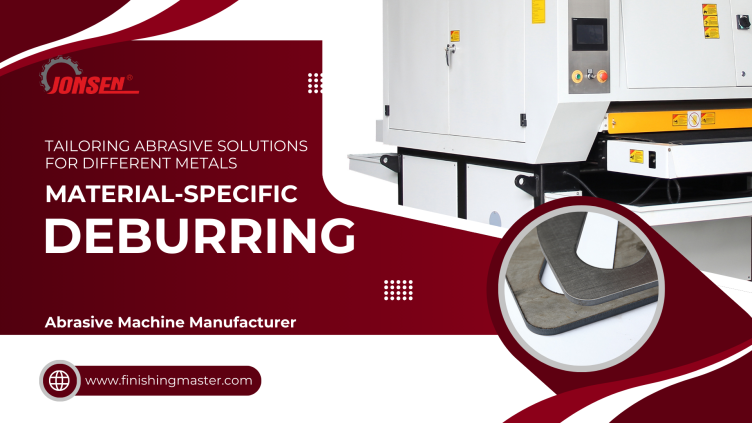
Metal Levelling: From Distorted Sheets to Profitable Production
In manufacturing, companies often promote their automation investments, digitalization initiatives, or advanced robotics. Yet in many factories, the biggest losses in time and cost come not from programming errors or machine downtime, but from distorted sheet metal. Parts that appear visually acceptable frequently hide residual stresses that reveal themselves only during welding, painting, or assembly.
When fixtures don’t align, welds pull apart, or painted surfaces show irregularities, production teams often spend hours reworking components. These costs accumulate silently, undermining efficiency and eroding margins. Metal levelling—or metal leveling in American spelling—addresses this issue directly by creating sheets that are both flat and stress-free.
This article explores the business case for metal levelling, from understanding residual stresses to quantifying ROI, and outlines how modern precision levellers help companies transform distortion into profitability.
Every sheet of metal carries an invisible history. Rolling stretches grains unevenly. Laser or plasma cutting introduces localized heating and cooling. Punching and stamping impose mechanical strain. These processes leave behind residual stresses, which cannot easily be measured without destructive testing.
The problem is not just warping at the moment of processing—it is the unpredictability of future distortion. A part may leave the cutting station flat, only to twist hours later when clamped into a welding jig. Or it may buckle after painting, when thermal cycles release trapped tension.
Residual stresses cost money in three ways:
Increased scrap – parts rejected after downstream distortion.
Rework time – operators manually correcting bent panels.
Hidden inefficiency – robotic systems or automated fixtures requiring adjustment.
For decades, manufacturers relied on manual approaches: hammering, heating, or using press brakes to flatten sheets. While effective in small batches, these methods are slow, inconsistent, and heavily dependent on operator skill.
A skilled technician may spend 10 minutes correcting a single part.
Results vary—two operators might deliver two different outcomes.
Availability of skilled labor is declining, increasing costs further.
In a high-volume environment, manual levelling is not sustainable. The need for a repeatable, fast, and automated solution paved the way for precision roller levelling.
Roller levelling is based on elastic–plastic alternating bending. The sheet passes through a sequence of staggered rollers. At the infeed, the rollers bend the sheet beyond its natural curvature, exceeding the material’s yield point. As it progresses, the alternating bends become progressively smaller, like a diminishing sine wave.
The result is twofold:
Flatness correction: visible distortions are eliminated.
Stress relief: hidden residual stresses are neutralized, ensuring stability in later processes.
This dual effect is why roller levelling is considered the gold standard for sheet metal preparation in modern fabrication.
Let’s calculate the economics for a mid-size fabrication plant:
Annual volume: 30,000 laser-cut parts.
Manual levelling: 10 minutes per part at $65/hour → $325,000 per year in labor.
Precision roller leveller: 1 minute per part at $150/hour machine cost → $75,000 per year.
Annual saving = $250,000.
That figure does not include reductions in scrap, warranty claims, or delayed deliveries. When these are factored in, payback for a levelling machine often occurs within 12–18 months.
Flat, stress-free sheets deliver measurable benefits across the value chain:
Welding: Parts align naturally, reducing fixture adjustments. Welds are uniform, distortion is minimized, and robotic welding becomes more reliable.
Painting and coating: Smooth, flat surfaces prevent uneven film thickness or “orange peel” effects, improving aesthetics and corrosion resistance.
Assembly: Components slot into place with minimal force, reducing cycle times and error rates.
Automation: Robots depend on consistency. Distorted parts cause errors, downtime, or costly reprogramming.
By eliminating distortion at the source, metal levelling ensures smoother, faster, and cheaper production.

Suitable only for small batches or repairs.
Time-consuming, inconsistent, operator-dependent.
Effective for thick plates but slow and limited.
Often requires multiple passes, leaving hidden stresses.
Works for coil processing, especially surface waviness.
Limited stress relief across thickness, not ideal for cut blanks.
Applies incremental alternating bends.
Delivers both flatness and stress relief.
Handles a wide thickness range (0.1 mm to 50 mm).
Fast, repeatable, and scalable.
For most fabrication shops, roller levelling offers the most versatile and cost-effective balance.
When evaluating equipment, it is critical to look beyond marketing brochures. True performance comes from engineering design:
Rigid frame construction prevents machine deflection under high loads.
Small roll pitch ensures finer incremental bending, improving stress relief.
Back-up rollers support working rollers, preventing deflection in heavy-duty jobs.
Hydraulic gap control enables precise adjustments and wear-free operation.
Overload protection extends machine life and ensures safe operation.
Software automation calculates optimal settings, reducing operator dependency.
Inline flatness measurement provides immediate feedback for quality assurance.
Machines with these features guarantee not just flat sheets but process reliability.
Automotive – Robotic welding lines demand consistent flatness. Metal levelling ensures panels fit seamlessly, improving both efficiency and safety.
Aerospace – High-strength alloys must remain stress-free to meet stringent tolerances. Roller levelling is essential for maintaining safety-critical dimensions.
Construction and Agricultural Machinery – Thick plate levelling improves structural stability and reduces field failures.
Rail Transit and Energy – Infrastructure requires long-term reliability; stress-free sheets prevent premature wear or distortion under heavy loads.
Medical Equipment – Even minor distortions can compromise performance in sensitive assemblies, making levelling non-negotiable.
The role of levelling is expanding with Industry 4.0. Modern machines now include:
Sensor integration to monitor roller penetration in real time.
AI algorithms that automatically adjust settings for different materials.
Data connectivity that integrates with MES systems for traceability.
Sustainability features that reduce energy consumption and scrap.
Levelling is no longer just a correction step—it is a strategic enabler of smart, sustainable manufacturing.
Founded in 1993, Hangzhou Xiangsheng Abrasive Machine Manufacturing Co., Ltd. has been a pioneer in surface treatment technologies for over 26 years. As the first establishment unit of China’s metal sanding machine standard, the company has authored 20 industry standards and holds 23 invention patents with more than 80 utility model patents.
With over 10,000 customized solutions delivered, Xiangsheng serves industries ranging from automotive and aerospace to nuclear power and medical equipment. Its portfolio includes deburring machines, wide belt grinding systems, and precision metal levelling solutions.
By combining technical innovation with customer-driven problem solving, Xiangsheng ensures manufacturers gain reliable, efficient, and profitable levelling capabilities.

Q1: How does roll pitch optimization influence stress-relief depth across different thickness ranges?
Smaller roll pitch delivers finer alternating bends, essential for thin sheets (<2 mm). For thicker plates (>20 mm), pitch must balance bending force with machine rigidity. Advanced levellers often integrate variable pitch or back-up roller support to achieve uniform stress relief across the full thickness range.
Q2: What challenges arise when levelling high-strength steels or aerospace alloys?
High-strength materials demand significantly higher bending forces, which can cause roller deflection or frame distortion in basic machines. Precision levellers use servo-hydraulic gap control and reinforced frames to maintain tolerances. Without these features, parts may appear flat but retain hidden stresses that compromise weld integrity.
Q3: How does roller levelling compare to stretch or tension levelling in terms of residual stress profiles?
Stretch/tension levelling applies uniform longitudinal stress, reducing coil waviness but leaving mid-thickness stresses untouched. Roller levelling applies alternating plastic bends through the sheet’s cross-section, neutralizing stresses more effectively for cut blanks and welded components.
Q4: What parameters determine whether a part can be levelled in one pass or requires multiple passes?
Key variables include material thickness, yield strength, initial flatness deviation, and part geometry. Complex geometries or heavily heat-affected laser-cut parts may require two passes, often with different roller penetration depths, to achieve complete stress relief.
Q5: How do automated recipe systems and flatness sensors change production economics?
Software-controlled systems calculate optimal settings based on material data, reducing operator variability. Integrated sensors verify flatness inline, eliminating post-process inspection. Together, these features reduce scrap rates and make levelling predictable, which is critical for automotive Tier 1 suppliers.
Q6: What are the trade-offs between using a universal leveller vs. dedicated machines for thin sheet and heavy plate?
Universal machines cover broad ranges but may sacrifice cycle time or precision at extremes. Many manufacturers invest in two dedicated machines: one optimized for thin, high-precision sheets (<3 mm) and another for heavy plate (>25 mm). This reduces tool wear, increases throughput, and ensures each machine operates within optimal design parameters.
Q7: How can preventive maintenance strategies extend leveller service life?
Beyond standard roller inspection, leading practices include hydraulic system oil analysis, predictive bearing replacement based on vibration monitoring, and frame alignment checks. These measures ensure machines sustain flatness tolerances even after processing millions of parts.
Q8: In what scenarios does levelling directly improve robotic welding accuracy?
Inconsistent panel flatness disrupts robot path repeatability and fixture positioning. By eliminating residual stresses, levelling ensures panels remain stable during clamping, minimizing weld pull distortion. This is particularly critical in EV battery housing and aerospace fuselage assembly.
Distorted sheets may seem like a minor nuisance, but in reality, they are a hidden cost driver. Metal levelling transforms this liability into an opportunity: fewer rejects, faster processes, and stronger customer satisfaction.
With the right equipment, manufacturers not only eliminate distortion but also gain a strategic advantage in efficiency and profitability. Companies like Xiangsheng provide the expertise and technology to make that transformation possible.
联系我们
地址
浙江省杭州市余杭区彭安路53号
中国杭州
电子邮件
kenny.gong@vip.163.com
17767176257@163.com
电话
电话:+86 17767171031
+86 13968085257
传真:0571-88524367

琼森砂光机是国内领先的钣金去毛刺机、磨床、宽带磨床、倒棱机的生产厂家、厂家和供应商之一,我们的产品质量已通过国际认证,而且价格实惠,欢迎来电订购我们的产品批发。
版权所有:杭州祥生砂光机制造有限公司 杭州大师撑腰